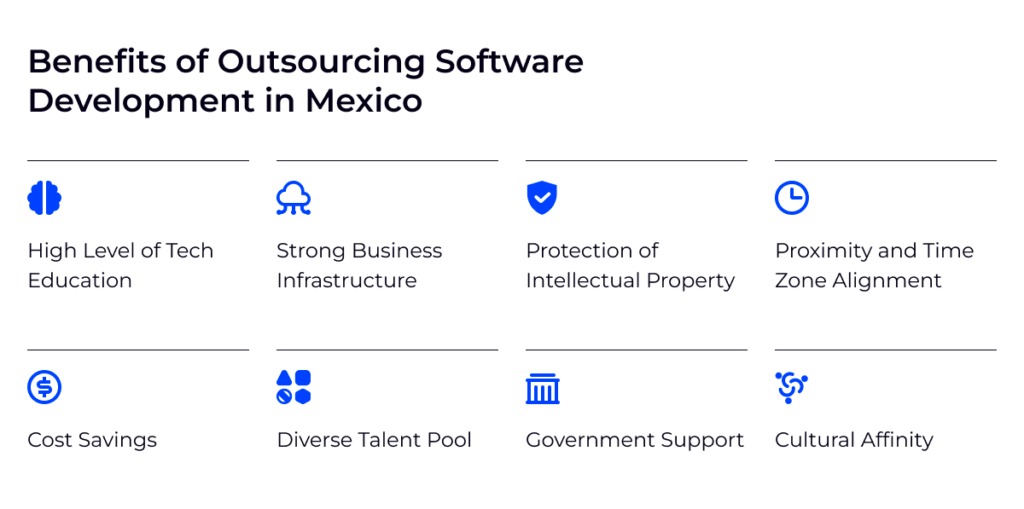 News
News
What makes Mexico one of the most exciting tech hubs in the world? Is it the influx of highly skilled developers, the rapidly growing innovation ecosystem, or the perfect balance of quality and cost-effectiveness? Maybe it’s all of the above. From fintech breakthroughs to AI-powered solutions, Mexican software engineers are using the latest technologies to build powerful, industry-shaping applications. But which popular Mexican tech stacks are leading this revolution? In this article, we look into the top 10 tech stacks fueling Mexico’s software development scene while exploring what makes them stand out, where they shine the most, and why businesses are embracing them more than ever.
Mexico’s Expanding Role in Global Tech Development
Over the past decade, Mexico’s tech industry has witnessed exponential growth, fueled by government support, foreign investments, and a thriving startup culture. Cities like Guadalajara, Monterrey, and Mexico City have evolved into major tech hubs, attracting global companies and fostering a new generation of highly skilled software engineers. One of the key reasons for this boom is Mexico’s strong educational system, which produces thousands of engineering graduates every year. Universities and coding boot camps continuously update their curricula to align with industry demands, ensuring that Mexican developers are proficient in the latest technologies.
Also, nearshore outsourcing has positioned Mexico as a prime destination for North American businesses looking to reduce costs without compromising quality. The country’s proximity to the U.S., shared time zones, and cultural alignment make collaboration seamless, allowing companies to scale their development efforts efficiently. With such a dynamic tech ecosystem, Mexican developers are working with a variety of powerful and popular Mexican tech stacks to build everything from scalable web applications to AI-driven solutions. Let’s take a closer look at the top 10 tech stacks shaping software development in Mexico today.
A Top 10 List of Tech Stacks in Mexico
1. Elixir and Phoenix – High-Concurrency Applications at Scale ↬
Elixir, a functional programming language built on the Erlang Virtual Machine (BEAM), has been gaining traction in Mexico, particularly for real-time applications that demand high concurrency and fault tolerance. Many startups and enterprise companies are turning to Elixir due to its lightweight processes, scalability, and reliability.
When combined with the Phoenix framework, Elixir becomes an excellent choice for:
Messaging platforms like chat applications and customer support systems
Live dashboards and real-time analytics tools
Fintech applications that require high-speed transaction processing
Many companies in Mexico’s fintech and telecommunications sectors are adopting Elixir and Phoenix to build robust, low-latency systems that can handle thousands of simultaneous connections without performance degradation.
2. Rust – The Future of High-Performance and Secure Software ↬
Rust is quickly becoming a favorite among developers in Mexico, particularly those working on systems programming, embedded devices, and high-performance applications. Known for its memory safety without garbage collection, Rust allows developers to build blazing-fast, secure, and efficient applications.
Mexican companies using Rust include:
Cybersecurity – Rust’s strict memory management helps prevent vulnerabilities like buffer overflows
IoT and embedded systems – Rust is ideal for low-power devices in industries like smart agriculture and industrial automation
Financial technology – Rust’s low-latency execution makes it perfect for high-frequency trading platforms
As cybersecurity and IoT continue to grow in Mexico, Rust is becoming an essential tool for developers looking to build safe, high-performance applications.
3. Flutter – Cross-Platform Mobile Development Made Easy ↬
Flutter, Google’s UI toolkit, is revolutionizing mobile app development in Mexico by enabling developers to build iOS and Android apps from a single codebase. This efficiency makes Flutter an attractive choice for startups and enterprises alike.
Mexican companies are using Flutter to develop:
E-commerce apps – Fast, responsive shopping experiences for online businesses
Fintech solutions – Secure and visually appealing mobile banking applications
On-demand services – Ride-sharing, food delivery, and healthcare booking apps
With its hot reload feature, Flutter significantly reduces development time, making it easier for companies to bring new products to market faster.
4. Scala with Akka – The Powerhouse for Big Data and AI ↬
Scala, a powerful hybrid programming language combining functional and object-oriented paradigms, is widely used in Mexico’s big data and AI industries. When paired with Akka, a toolkit for distributed and concurrent applications, Scala enables companies to handle large-scale data processing efficiently.
Common use cases in Mexico include:
Machine learning pipelines – Optimized data processing for AI training models
Real-time analytics – Large-scale event streaming for business intelligence applications
Cloud-native applications – Scalable solutions for enterprise software
With an increasing number of data-driven businesses in Mexico, Scala is becoming a go-to language for AI and big data applications.
5. Haskell – Functional Programming for Secure and Reliable Software ↬
Haskell is a purely functional programming language gaining traction in Mexico, particularly among fintech and cybersecurity firms. Its strong type system and mathematical precision make it an excellent choice for applications requiring high reliability and security.
Common use cases in Mexico include:
Cryptographic applications – Used in blockchain and secure financial transactions
Quantitative finance – Risk modeling and high-precision financial computations
Mathematical simulations – Used in scientific research and engineering applications
Haskell’s immutability and lazy evaluation provide developers with a robust framework for handling complex data structures without side effects.
6. Django with PostgreSQL – A Secure and Scalable Web Stack ↬
Django, a high-level Python web framework, paired with PostgreSQL, is widely used in Mexico for enterprise applications, government portals, and fintech solutions.
This stack is favored for:
Security-first web applications – Built-in protection against SQL injection, CSRF, and XSS attacks
Data-driven platforms – PostgreSQL’s powerful indexing and full-text search capabilities
API development – Rapid backend development for SaaS products and internal tools
With Mexico’s growing emphasis on digital transformation, Django and PostgreSQL remain a reliable choice for scalable web applications.
7. Clojure – Functional Programming for AI and Automation ↬
Clojure, a Lisp-based functional language, is emerging as a key player in Mexico’s AI and automation sectors. Its immutable data structures and parallel computing capabilities make it well-suited for:
Predictive analytics – AI-driven market forecasting and trend analysis
Chatbots and NLP – Automating customer support interactions
Autonomous systems – Robotics and automated decision-making tools
Clojure’s simplicity and efficiency make it an excellent tool for handling complex AI computations in real-time.
8. GraphQL with Apollo – A Modern API Development Stack ↬
GraphQL, a query language for APIs, is becoming the preferred choice for building fast and flexible APIs in Mexico. When combined with Apollo Client, GraphQL enables efficient data fetching, real-time updates, and improved developer experience.
Industries benefiting from GraphQL include:
E-commerce – Personalized product recommendations and faster search queries
SaaS platforms – Efficient data synchronization between frontend and backend
Mobile apps – Reducing over-fetching and under-fetching of API data
As businesses shift toward microservices and headless architectures, GraphQL is becoming a game-changer for modern web applications.
9. Kubernetes with Helm – Scalable Container Orchestration ↬
Kubernetes has become the backbone of cloud-native development in Mexico, allowing businesses to automate the deployment, scaling, and operations of containerized applications. When paired with Helm, developers can manage Kubernetes applications more efficiently, making it a go-to stack for enterprises and startups alike.
Why Mexican companies use Kubernetes and Helm:
Cloud-native applications – Ideal for deploying scalable SaaS platforms and enterprise applications
DevOps automation – Streamlines CI/CD pipelines, reducing deployment complexities
High availability – Ensures reliability in mission-critical applications
As cloud adoption grows in Mexico, Kubernetes with Helm is becoming a key stack for companies looking to optimize their infrastructure.
10. Go (Golang) with Gin – High-Performance Backend Development ↬
Golang, known for its simplicity, speed, and concurrency capabilities, is widely used in Mexico for backend development, microservices, and networking applications. The Gin framework enhances Go’s performance by providing a lightweight, fast, and modular web framework.
Examples of uses for Go and Gin in Mexico:
Fintech APIs – Secure and efficient backend services for financial applications
Cloud services – High-performance microservices architecture for scalable platforms
Real-time applications – Chat applications, gaming backends, and streaming services
With an increasing demand for performance-driven backend systems, Go and Gin are solidifying their place in Mexico’s software development ecosystem.
Hire Tech Talent in Mexico with Blue Coding
Looking for elite software engineers in Mexico? Blue Coding makes outsourcing to Mexico easier as it connects businesses with skilled developers who excel in technologies and programming languages. Whether you need cloud engineers, AI specialists, or mobile app developers, we can help you build the perfect nearshore team. Contact us today and book your free discovery call to discover how nearshore development in Mexico can accelerate your software initiatives.




